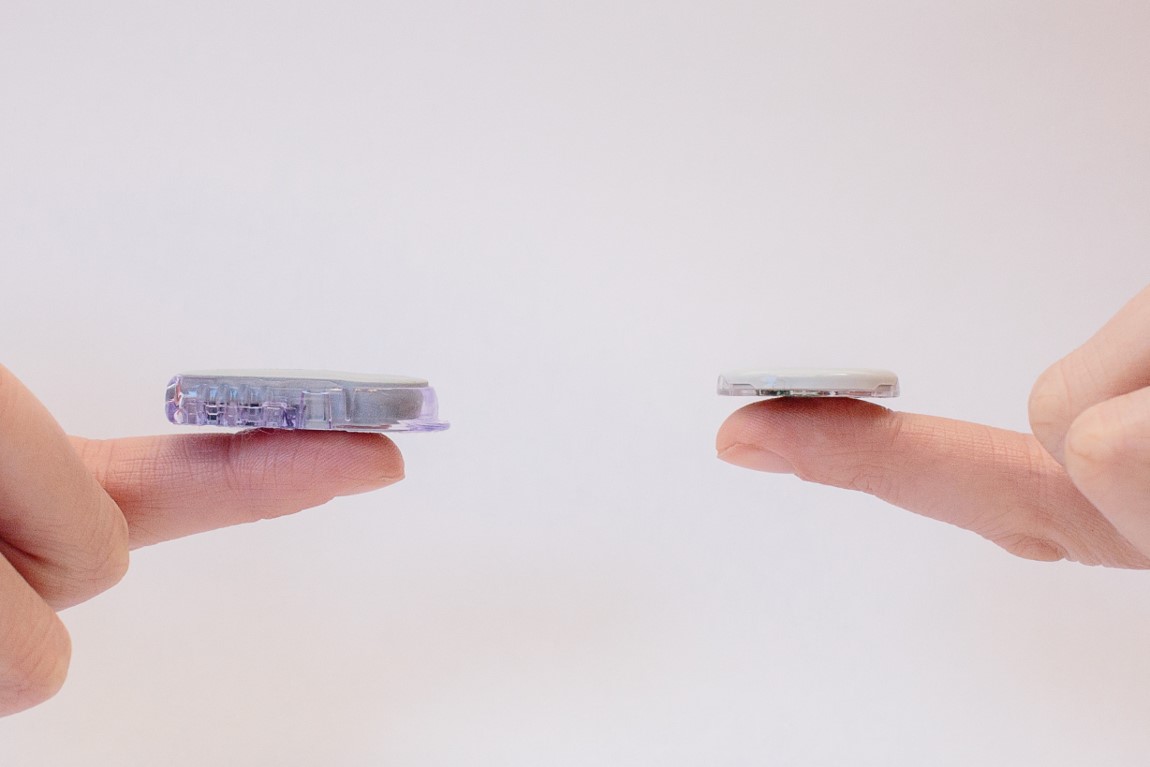
We are almost through to the end of this year and we are all looking forward to new diabetes technologies coming out in 2021! Continuous glucose monitoring (CGM) technology is an incredibly useful tool that can improve diabetes management, and the release of Dexcom’s new CGM, the G7 is certainly one to look out for. For me, the sheer difference in size alone (the G7 will be about the size of a quarter, certainly an improvement over the G6!) is something to get excited about. Moreover, the company has completely redesigned the product, which will now be completely disposable, as opposed to previous iterations that included a reusable transmitter.
I recently talked to Dexcom’s Chief Technology Officer, Jake Leach to get the most recent scoop on what’s to come with the release of the highly anticipated new product.
When Will the G7 be Released?
Due to the COVID-19 pandemic, the start of clinical trials was delayed. Leach explained that the company used that time to integrate in even more technology with the G7. Clinical studies needed to get FDA approval for the G7 are currently in the process of getting started. Although they could not disclose specific details on timing, Dexcom confirmed that will see the product come to market in 2021. A broader launch is expected to come in 2022.
What About the Accuracy?
Dexcom has taken a lot of technologies of the G6 and made improvements on them. It will need to meet stringent accuracy requirements to be approved by the FDA. It is expected that the product will perform well and offer improvements over existing technologies.
What About the Wear Time?
Currently, the Dexcom G6 is approved for 10-day wear. However, many users try to circumnavigate this. Dexcom’s CTO had this to say about advancements for the G7:
“The platform is designed to extend the wear beyond 10 days, so the electronics, etc. are compatible with that. We are striving for a very high level of reliability for both the sensor and the adhesive patch. [So far, early studies have shown that] the right time frame for our customers is 10 days with this product, but we do intend to continue working to expand both the sensor and adhesive performance to go beyond 10 days. We feel that our customers deserve a sensor that is highly reliable for the full wear duration, and so 10 days is where we’re at with G7.
What About the Cost?
“We know that for CGM to be accessed by many many people, we need to continue to remove cost from the general system. So, G7 is designed to be highly manufacturable in very large volumes. We have our first G7 line up and running. We are using a fully automated assembly line. The product is not only highly reliable but also lower cost to manufacture. Providing users with the product that is disposable, there were hurdles that we had to overcome in engineering, to be able to provide a product where you are throwing away more components, but we are able to do that at a cost-point equal to or lower than G6.”
What About the Sensor Insertion?
The sensor insertion will be fully automated. Dexcom stated that the product will be even easier to apply than the G6, and that the applicator will be much smaller than the G6, reducing the environmental footprint.
“We specifically designed it to be as small as possible [but still large enough to ensure a comfortable insertion process]. Definitely smaller than G6…”
What About the Adhesive?
In the diabetes online community, I have recently been hearing more reports of adhesive-related allergic skin reactions, and speculations that perhaps there was a change in the adhesive formula being used. Here is what Dexcom had to say about that:
“Some very small number of users do have issues with irritation, and there is a number of different ways that can be addressed. It’s a balance between the adhesive properties of making the sensor stay on for the full duration and there are so trade-offs with irritation. We are very focused on minimizing irritation. We have made improvements to the patch where many users are seeing their sensors last longer, but we have seen a small number of irritation complaints and we are focused on [for both the G6 and the G7] always making improvements. We are focused on investigating what possibly could be causing these irritant properties. The G7 does have a different adhesive than G6 and we are looking to ensure that [causes] very little, if any, irritation.
What About New Integration with Other Systems?
“The way that we’ve designed our system is so that it can integrate with many different types of systems.”
In addition to integration with the Tandem’s Control IQ and Insulet’s OmniPod system, integration has also been developed for Companion Medical’s InPen as well as over 25 commercially-available apps. Leach also highlighted that as of now, the Dexcom CGM is the only product that has been approved for use with hybrid closed-loop insulin delivery systems.
What About New Predictive Modeling Algorithms?
Recently, Dexcom has partnered with the University of Virginia to conduct research on a variety of automated insulin delivery models and algorithms. Dexcom has also partnered with the European company Ypsomed to further develop CGM integration for automated insulin delivery systems. In addition, Dexcom is working to investigate the use of CGM data, in general, to provide users with key insights on blood glucose trends and potential therapy optimizations.
“Our general approach is to provide many options to our users. We know diabetes is a personal disease and everyone has different opportunities to connect with different devices, and what they feel fits into their lifestyle. We try to support as many options as possible so we do that through the pump integration, as well as the digital ecosystem of the app partners.”
What About the Data Display and Device Compatibility?
“It will be compatible with both Android and iOS. One thing we are doing with the G7 app is we are integrating more insights into the app. So, G6 does a great job of showing glucose information, trends, as well as the ‘urgent low soon’ alert. G7 is taking that even farther and starting to integrate in a lot more of the some of the functionality from Clarity, some of those insights you get will be built into the G7.”
Dexcom is also working to enhance some features of their apps for data sharing with support people and clinicians. In addition, a receiver will still be a part of the new system, for those users who want an alternative to using their smartphone for data display.
Staying Ahead of the Competition
The CGM market is growing rapidly, with more and more companies coming out with competitive products. We asked Dexcom where they view themselves and what their advantages are over other systems.
“We feel that G7 is going to be a whole new level of comfort and convenience in the CGM ecosystem and the integration that we can build on with both insulin pump partners and the digital ecosystem of apps… is a significant differentiator between [us] and some of the other competitors. We’ve been providing real-time CGM data since day 1, and we want to continue to expand and improve and provide users with new tools that enable them to take control of diabetes.
Moreover, the use of CGM technology is also expanding in the clinical setting, and Dexcom is a big player there.
“With COVID, we got approval for emergency authorization use for Dexcom CGM in the hospital. During the pandemic, since the beginning, hospitals have been acquiring the G6 from us and using the device in the hospital setting. It has performed very well. It also limited the need for interaction between healthcare providers and the patients [with COVID].”
We thank Jake Leach for taking the time to provide us with the most updated information. Sounds pretty great to us, and we look forward to learning even more and updating our readers as more details come to light!
Do you use a Dexcom CGM? What are your thoughts on the advances in CGM tech? Please share your thoughts in the comments.
Post Views: 3
Related Post
 13
13 Dec
Are People Mental Health Problems Not Attracted to Children?
Are People Mental Health Problems Not Attracted to Children? As per a concentrate by the College of Michigan's Wellbeing Lab, upwards of 1 of every 7 youngsters in the US are at present experiencing an undiscovered treatable emotional well-being issue. Remaining.
Read More 02
02 Dec
Does Ambetter Cover Virtual Mental Health Visits in Georgia?
Does Ambetter Cover Virtual Mental Health Visits in Georgia? Ambetter from the Peach State Wellbeing Plan serves underprotected and uninsured populations through Georgia Access. Ambetter from Peach State Wellbeing Plan is endorsed by Ambetter of Peach State, Inc., which is a.
Read More 18
18 Nov
Is There a Good Place to Stop Leveling Health Skyrim?
The blemish in Skyrim's evening out framework is by they way it grants capacity to the player, and capacity to the players resistance through unequivocal means. For instance, by work in abilities. Is there a good place to stop leveling health.
Read More 06
06 Nov
What Type of Cancer Did Morgan Spurlock Have?
Morgan Spurlock, the producer and previous CNN series have whose McDonald's narrative Super Size Me was selected for an Institute Grant, passed on from disease confusions Thursday, as indicated by his loved ones. What Type of Cancer Did Morgan Spurlock Have? The.
Read More